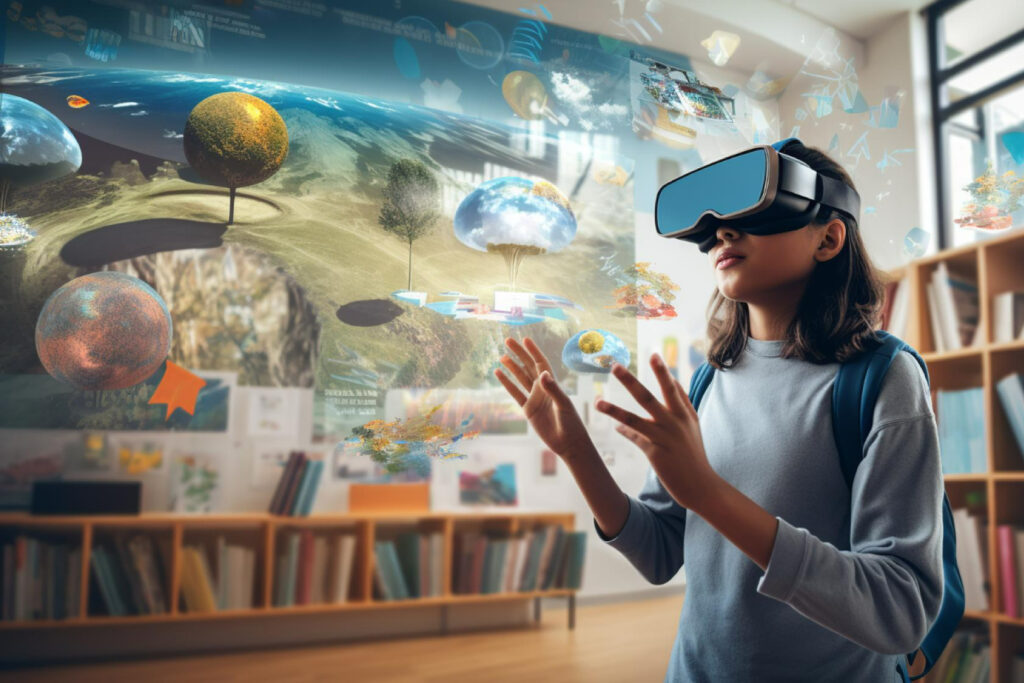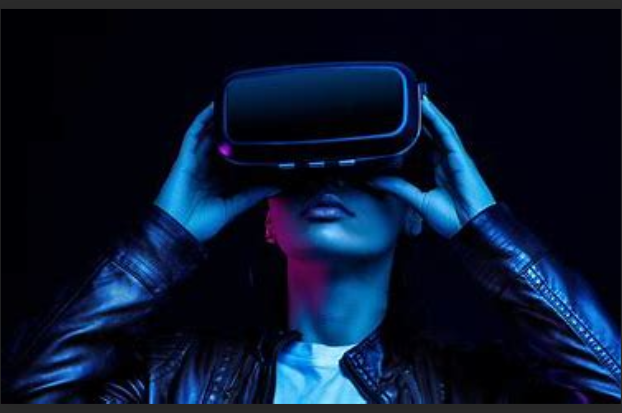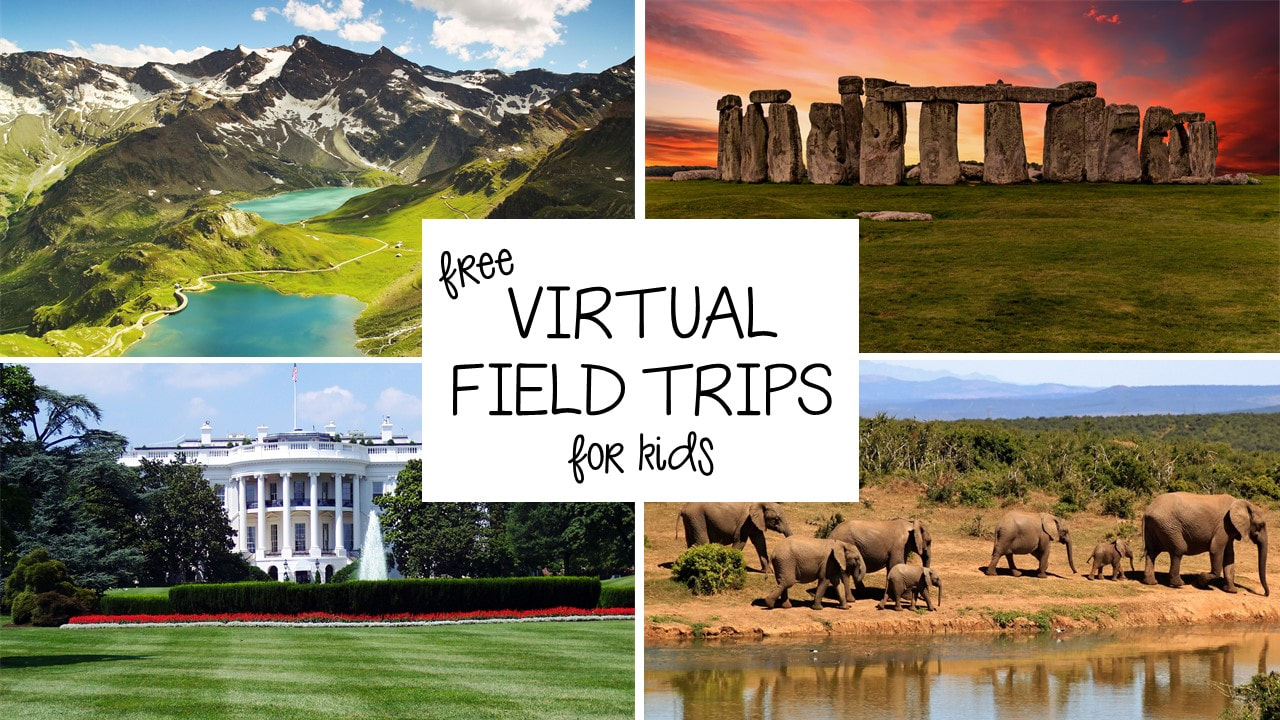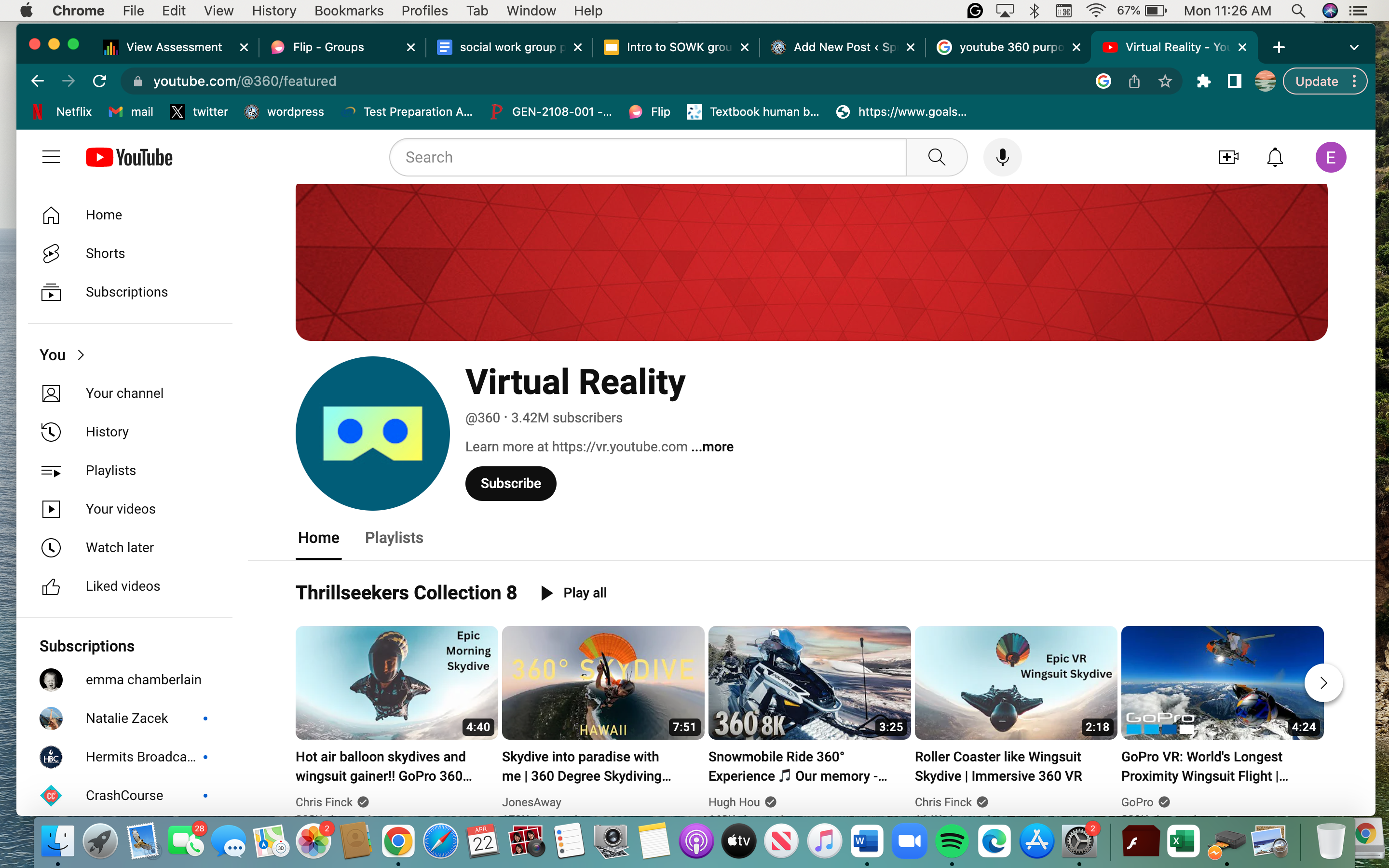Home » Uncategorized (Page 5)
Category Archives: Uncategorized
Enhancing Global Collaborations in Education through Virtual Reality: A Journey into Immersive Learning

Introduction:
The use of augmented reality (AR) and virtual reality (VR) in education has opened up countless possibilities for immersive learning experiences at a time when technology is rapidly advancing. These tools, which provide students with an avenue to experience the world outside of textbooks, have transformed traditional classroom settings. They range from engaging virtual field trips to interactive simulations. The real potential of VR and AR, however, is found in promoting international student cooperation in addition to enhancing solitary learning. We examine the revolutionary possibilities of VR and AR in K–12 education in this blog article, as well as how they might act as catalysts for fruitful international cooperation.

Exploring the Landscape of VR and AR Tools:
Prior to exploring the world of international cooperation, let’s become acquainted with some of the major VR and AR resources that are changing the face of education. Websites such as Veative, Nearpod, and YouTube 360 films have become indispensable tools for teachers who want to use VR and AR in the classroom to create immersive learning environments. With the extensive collection of interactive simulations that Veative provides, students can interact practically with difficult ideas. With Nearpod, instructors can easily include virtual reality (VR) experiences into their class plans, enabling them to provide engaging presentations for their students. In the meanwhile, YouTube 360-degree films take students to far-off places, providing them with virtually limitless field trips.
Unlocking Global Collaborations:
Let’s now close the distance between international partnerships and immersive learning. Consider a classroom in New York using Veative’s lifelike virtual reality simulations to go on a virtual field trip to the Great Wall of China. Through the same virtual experience, students in Beijing, located halfway around the world, are likewise discovering the glories of their cultural heritage. Teachers can organize real-time collaborative sessions where students from several continents collaborate to solve interactive puzzles or dissect virtual specimens by using platforms such as Nearpod. Additionally, YouTube 360-degree films provide a global forum for students to share cultural experiences and exchange viewpoints and thoughts from around the globe.

Lesson Plan: Journey Across Continents
Objective:
To facilitate global collaborations and cultural exchange through immersive VR experiences.
Materials Needed:
– Veative VR headset or compatible VR devices
– Nearpod presentation with interactive VR content
– YouTube 360 videos showcasing cultural landmarks
– Internet-enabled devices for each student
Procedure:
1. Introduce the concept of global collaborations and the importance of cultural exchange in today’s interconnected world.
2. Divide students into groups, ensuring diversity in geographical backgrounds.
3. Provide each group with access to Veative VR headsets or compatible VR devices.
4. Guide students through a virtual field trip to a culturally significant landmark using Veative’s immersive simulations.
5. Encourage students to take notes and reflect on their experiences during the virtual journey.
6. Reconvene the class and facilitate a collaborative discussion using Nearpod’s interactive VR presentation.
7. Allow students to share their insights and observations, fostering dialogue across cultural boundaries.
8. Conclude the lesson with a screening of YouTube 360 videos showcasing various cultural landmarks, encouraging students to explore and appreciate the diversity of our world.
Conclusion:
Overall, the incorporation of virtual reality and augmented reality into educational settings presents significant opportunities for promoting cross-cultural cooperation and understanding among students. Through the utilization of immersive technology, instructors have the ability to surpass geographical limitations and offer students chances to investigate varied viewpoints and participate in significant cross-cultural interactions. Let’s take a collaborative step towards a future that is more compassionate and interconnected as we embrace the revolutionary potential of virtual reality and augmented reality in education.

Virtual and Augmented Reality
the Use of VR could be a very useful thing when it comes to teaching kids. From my perspective as a student it was best to learn when there where different websites and fun activities to do. Now with all the technology on the rise VR could be a very use full thing in the classroom. VR is very cool because it allows students to go to places in VR that they have never been. VR is very cool and how you can go anywhere you want and feel like you are in it. Like for an example in a history class you are learning about the great pyramid. Although students may never get to go there, they can use VR to see what it is like to be near the pyramids. these student will get to experience a different type of learning thought VR which could be very good in the future with how technology is advancing.

Virtual Reality and Global Collaboration

Technology holds the key to a successful and collaborative future. Billions of people live on this planet speaking different languages, living in diverse cultures, and practicing various lifestyles. There are many apps that connect the worlds of virtual reality and reality but one that I was thought great for all ages was YouTube360. This allows the person to discover anything! Space, oceans, do-it-yourself projects, political affairs, and practicing for job interviews can all be simulated through this app. One feature that I feel that can globally collaborative is a simple cooking educational experience. Many cultures exist and they can come together through this app without the worry of a language barrier or restrictions. Cooking lessons, advice, ideas, and kitchen safety can all be simulated through this app in the classroom and at home. This feature will help connect many people with the needed skills required when they become adults or even help adults with disabilities.
The Making of a 360° VR Recipe Video | Food Network (youtube.com)
Cooking Simulator | 5 Star Career Run | NO COMMENTARY | Casual and Relaxing Gameplay (youtube.com)

Virtual Trips Around the World
Virtual and augmented reality has become an incredible tool and resource for education and learning. One of my favorite applications of this technology is its use for virtual field trips. Field trips can be an amazing opportunity for students to learn more about the world in an engaging and exciting format. Yet field trips are often expensive and difficult to set up. Plus there are always restrictions on distance.

However, with the use of virtual reality and augmented reality, students can participate in digital field trips from within the school itself. Without evening have to leave school grounds students can explore museums, monuments, and more from anywhere across the globe.
Advantages of Augmented and Virtual Reality.
By being able to visit locations around the world. It also allows students from classes in different countries to collaborate and visit the same locations virtually despite massive distances. Students from different countries can learn about each other’s country and its history together by visiting important landmarks and museums, collaborating in a way that would be impossible without virtual or augmented reality.

This article 5-Minute Film Festival: Teaching With 360-Degree Videos provides a few basic examples of augmented reality field trips that can be used for education. While these examples are fairly simple compared to more advanced augmented reality or virtual reality, they help provide an entry point for teachers interested in including this type of application in their classrooms. Some of the field trips included in the article are a virtual guided tour of pairs, An interactive view of the solar system, and a view of a Romaleosuarous.
Virtual and Augmented Reality YouTube 360
YouTube 360 is a great tool that can contribute greatly to successful global collaborations now and in the future as the technology continues to improve. With the YouTube 360 tool you can use things similar to google maps to visit places and collaborate with classes all over the world. You could take your class to the school you are collaborating with that could be a thousand miles away. Or you could have a joint field trip that sends you up into space with another class that you are communicating with across the globe. The videos down below are some examples of what global collaboration can be like with YouTube 360 as it continues to evolve as a piece of technology. For the tour of space and tour of the ocean students can work with their own class and go into this VR to meet another school. Where they go through the ocean tour together and work together to find different animals, plants, and places in the oceans. It could be like a online multiplayer scavenger hunt type game in the ocean that can be played with different classes around the world. The space game can be the same thing except identifying the planets, the moons of these planets, stars, and constellations. Your students can work with other classes around the globe to figure out which of these are which and they can work to get the highest score or receive a prize for how well they do in the game with YouTube 360. I think it will be such a great tool to use in the future and there are so many possibilities of involving this global collaboration within YouTube 360. You can also use the tsunami video to learn about the phenomenon while playing a fun interactive game to try to escape the natural disaster with people around the globe. Working together and trying to stay alive with people from around the world. There are so many different ways to learn about so many different things with YouTube 360 and ways in which we can collaborate with others around the globe. I can only see this technology growing tremendously in the coming years and it being further integrated into schools across the globe.

AR in the Classroom
JigSpace is an app that can be used to create and view 3D models that allow people the opportunity to explore different things such as machines, space, and more. Teachers can use this app to better immerse students into the lesson and get them more excited about learning! There is so much that can be done and seen with a resource like JigSpace, and it can help students better understand what they are being taught. While teacher’s are their as a guide, students may be mainly in charge of getting a closer look at what they are learning.
Global Collaboration
When collaborating with others about global issues, JigSpace can be a huge resource to show others what is going on and how they can help. The app can be used to share designs of issues going on between classrooms, teachers, schools, etc. This way, students can see up close what is happening and how it affects those around the area. Students can then come up with their own designs based on what they think might help the problem and how it can be fixed. For example, someone might send a classroom a design of a community with no clean water source, and the students may come up with their own design of a water filter that can help!

Sometimes the problems won’t be easily solved and will need more work, or is simply an issue the students cannot come up with the solution for, and that is important to keep in mind. There are many global issues that need to be worked on, and none of them are simple or have simple solutions, so it’s important for students to know that and keep it in mind. By knowing this, it teaches students that they may need to ask for help or have patience that progress may take a while to show.
Why AR and VR?
AR and VR are becoming more popular everyday, and it is important for classrooms to keep up with the latest technology that is appropriate for school. Not only does it keep students engaged and enjoying their own learning, but it teaches students how to get the most out of the technology they are most likely using on the daily anyway. There will come a time where AR and VR are used as commonly as computers, and may become just as important in education. Therefore, students should be able to learn about such technologies in their schools and have them available to them to learn.
How Can VR Contribute To Successful Global Collaborations?
Virtual reality is often misunderstood by people and how to properly use it. VR is best used individually. It allows students to learn at their own pace, while attaining as much information as possible. Veative is a VR platform that can be used in classrooms. It allows students to focus on certain aspects of the lesson at their own pace. Platforms like Veative can contribute to successful global collaborations because it will allow students to improve their understandings of what is truly going on in the world and what people around the globe are doing to contribute. Veative will allow students to learn about the importance of those around us in an untraditional way, which will make it more interesting for students to globally collaborate with others.
In this video it shows how VR is used in the classroom when used. This will help better your understanding of how VR can be implemented in any aspect of life really. Take a look! https://youtu.be/L9g-y2fLG6g?si=AKqSzmORlGQ90fDr
In our global goals project we connected with those around us via video. With VR we can connect with those around the world and feel like we are in the same room as them. This will build bigger connections and allow students to understand what other people are going through. This form of global collaboration will only allow students to build skills that there is so much to be learned about globally. Informative global videos will only become more interesting to its audience and will allow people to be as create as they wish on connecting with others about global issues.

This is an image of what the VR Veative head set looks like. It is specifically made for classrooms.
Virtual Reality- Youtube 360

YouTube 360 is a great Virtual Reality tool that helps creators use these features to upload 360-degree videos in a collaborative space. This tool gives an amazing experience for viewers watching as well as the creators themselves to be creative with the content. There are many different collections to view on this YouTube platform with many kinds of experiences to be a part of. Virtual reality gives a realistic view that makes you feel you’re inside the video or really experiencing what’s happening. Virtual reality is a way to watch content on a personal level and messes with your senses as it puts you somewhere that is not really existent. Virtual reality lets viewers be immersed in their surroundings which really arent existing. There are three types of virtual reality, non-immersive, semi-immersive, and fully-immersive. YouTube 360 can be used in education, especially with students k-12 with appropriate supervision and moderation of what the students can view. There are virtual reality 360 videos that are about wildlife and bring you to different habitats and environments to really explore what it looks like. This helps students gain an understanding visually rather than reading in a textbook. There are also movies they can watch through YouTube 360. National Geographic provides so many informational videos. I think this tool is useful and provides so much opportunity to engage.
Enhancing K-12 Education Through AR and VR: Fostering Global Collaborations
The use of virtual reality (VR) and augmented reality (AR) technology into education has altered traditional classroom experiences in recent years. Students may study through immersive and interactive experiences that are unbelievably engaging thanks to platforms like Veative, Nearpod, and YouTube 360 films. We will look at these technologies’ possibilities in K–12 education and how they might help students and teachers collaborate successfully on a global scale in this blog post.

Veative
Veative is an educational VR solution designed to supplement traditional teaching methods with immersive experiences. With a vast library of interactive modules covering various subjects, Veative allows students to explore concepts in a virtual environment.
For example, students can dissect virtual frogs in biology class or travel through ancient civilizations in history lessons. By experiencing concepts firsthand, students develop a deeper understanding of the material.
In the context of global collaborations, Veative offers opportunities for students from different parts of the world to collaborate on projects and simulations. Through shared VR experiences, students can work together to solve problems, conduct experiments, and explore cultural differences.
Nearpod
Nearpod combines interactive presentations, virtual reality, and formative assessments to create engaging lessons for K-12 students. Educators can use Nearpod to deliver multimedia-rich content and gauge student understanding in real time. With features like VR field trips and 3D models, Nearpod brings learning to life and caters to diverse learning styles.

In the context of global collaborations, Nearpod facilitates virtual exchanges between classrooms around the world. Teachers can collaborate on lesson plans and activities, allowing students to learn about different cultures, languages, and perspectives. By connecting with peers from different countries, students develop a global mindset and appreciation for cultural diversity.
YouTube 360 Video
YouTube 360 videos offer immersive experiences that allow users to explore virtual environments from all angles. From virtual tours of famous landmarks to immersive storytelling experiences, YouTube 360 videos provide endless opportunities for experiential learning.
In the context of K-12 education, YouTube 360 videos can be used to supplement classroom instruction and provide students with virtual field trips to locations around the world. By experiencing different cultures and environments firsthand, students gain a deeper understanding of global issues and develop empathy for others.
The Importance
Integrating augmented reality and virtual reality tools like Veative, Nearpod, and YouTube 360 films into K–12 education has the potential to completely transform how students study and work together. These platforms engage students in ways that are not possible with traditional teaching approaches because they offer immersive and interactive learning experiences.

Additionally, they provide chances for international cooperation, enabling students to establish connections with classmates from many nations and cultural backgrounds. Students gain vital 21st-century skills via cooperation, including communication, teamwork, and cultural competency.
AR and VR have the ability to produce a generation of students that are more internationally aware and connected as we continue to embrace technology in education.
Global Collaboration
Explore Virtual Reality
Global Collaboration on virtual reality will expand learning in a substantial way. To collaborate with classes in other parts of the world. To go on field trips without every leaving the building is not only amazing, but also beneficial, and inexpensive.
Podcast: Play in new window | Download

